This is a Fujifilm GF670 Professional, a folding dual format medium format rangefinder camera, jointly made by Cosina and Fujifilm of Japan. The Fujifilm GF670 went on sale in March 2010 and was one of the very last Fujifilm cameras and shoots both 6cm x 6cm and 6cm x 7cm images on 120 or 220 format roll film. It is a high quality camera with a very bright and easy to use coupled rangefinder, features a high quality 6-element lens, a 12-speed shutter, and aperture priority automatic exposure. The GF670 was also sold as a Voigtländer Bessa III 667 with the only difference being the Bessa is only available in black. A non-folding wide angle version was also sold as the GF670W.
Film Type: 120 or 220 Roll Film (10/12 or 20/24 6cm x 6cm exposures per roll)
Lens: 80mm f/3.5 EBC Fujinon Lens coated 6-elements in 4-groups
Focus: 0.9 meters to Infinity
Viewfinder: Coincident Image Coupled Rangefinder w/ Automatic Parallax Correction, 88% Field of View, 0.7x Magnification
Shutter: Electronically Controlled Leaf Shutter
Speeds: B, 4 – 1/500 seconds (limited to 1/250 at f/3.5)
Exposure Meter: Silicon Blue Cell, Center Weighted Aperture Priority AE
Battery: 3v CR2 Lithium Battery
Flash Mount: Hot shoe, PC Sync Port, M and FP Sync, X Flash Sync At All Speeds
Other Features: Eyepiece Diopter, +/- EV Compensation, Full Manual Mode
Weight: 1016 grams
Manual: https://www.cameramanuals.org/prof_pdf/bessa_iii_fujifilm_gf670_prof.pdf
How these ratings work |
The Fujifilm GF670 Professional is a modern classic. It blends the best of mid century folding cameras into a modern design with auto exposure and one of the brightest and easiest to use rangefinders found on any camera. Using the camera is as easy as the simplest models, but can also shoot in full manual if you so desire. The shutter is extremely quiet, and the 80mm lens produces images as good as anything out there. Finally, the folding design means this camera is much easier to carry than most other medium format cameras of the same era. | ||||||
| Images | Handling | Features | Viewfinder | Feel & Beauty | History | Age | |
| 2 | 2 | 2 | 2 | 2 | 1 | 0% | |
| Bonus | +1 for overall perfection, a modern classic | ||||||
| Final Score | 12.0 | ||||||
History
In 2024, the Internet is full of information championing how well film photography is doing. New film stocks from niche companies and film cameras are being announced almost daily. In a recent episode of the Camerority Podcast, the guys and I discussed the recently released Pentax 17 half frame camera, the upcoming Rollei 35 AF, and re-release of the Widelux-X. Certainly with all of these new products and hype film really is back right?
Well, for one company, Fujifilm (which ironically has ‘film’ in their name), the jury’s still out. In the last decade, Fuji has discontinued nearly every single line of film it makes except Instax and a small handful of 35mm stocks. It seems odd that if film is really back, Fuji hasn’t made any announcements of new film stocks or a new film camera to take advantage of the upswing in interest.
If there’s one tiny bit of good news in this, is if you really want to experience shooting film in a Fuji camera, you don’t need to go very far back in time, as recently as 2010 the company released perhaps one of the best medium format cameras ever. The Fujifilm GF670 Professional predates only the non-folding GF670W as the company’s last medium format camera. An earlier black version of the GF670 came out a year earlier in 2009.
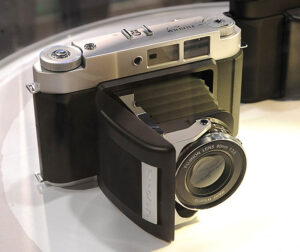
The first sign of a new medium format Fuji camera came in September 2008 at Photokina in Cologne, Germany when Fuji revealed the prototype to the left. The GF670 Professional prototype looks much like the finished model but with only a couple changes to the cosmetics. The logo on the top plate only mentions 6×7, and not 6×6, so it is not clear if that feature had not been included yet, or if it was simply just not printed that way.
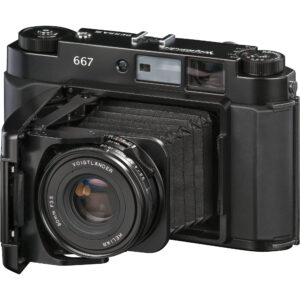
The Fujifilm GF670 Professional (I’ll call it the GF670 for the remainder of this article) was designed by Fuji, but built by Cosina in Japan who also owned the rights to the Voigtländer name and produced a version of this same camera as the Voigtländer Bessa III 667. The Voigtlander version of the camera only came in black, whereas the Fuji first came in black, but then a silver version was released later.
The GF670 is a blend of old and new. It has a traditional appearance, not unlike medium format folders of the mid 20th century like the Voigtländer Bessa II. When folded shut, the camera is a tad larger than a 1950s folding 6×9 camera, but compared to other 6×7 options like the Pentax 67, Mamiya RB67, or even Fuji’s own GW670III, the GF670 will fit inside a large coat pocket or medium handbag. This compactness is definitely one of the camera’s strengths as it gives it a level of portability not often associated with medium format cameras.
Improved from a mid century folding camera, the GF670 is equipped with a modern, and extremely quiet leaf shutter with a range of speeds from 4 to 1/500 seconds. Since it is a leaf shutter, it supports electronic flash sync at all speeds, which is great for people who need a fast flash sync to freeze motion. The camera has one of the largest and brightest coupled rangefinders I’ve ever seen. Easily on par with the best Leica M-series, just larger! The camera supports full manual control of shutter speeds and f/stops but also has the benefit of aperture priority auto exposure, certainly a feature you don’t often see on medium format folding cameras! Finally, the camera is dual format, supporting both 6×6 and 6×7. Switching between the two is done within the film compartment, so it can’t be done mid roll, but when switching between the two formats, the framelines in the viewfinder adjust accordingly.
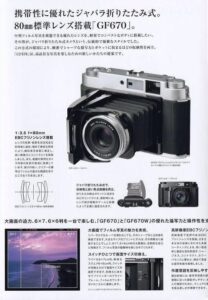
I could not find any period advertisements for the camera, but in an article on stevehuff.com dated June 2010, the price of the Fuji GF670 was listed as $1899 with the Voigtlander version strangely listing for $400 more. Since the two cameras were sold in different markets, it is possible the price discrepancy was due to differences in import fees or that perhaps Cosina simply charged more for the two cameras in certain markets. Whichever the case, when adjusted for inflation, $1899 compares to just over $2700 today.
There are many modern reviews of the GF670 online, but looking at two from around the time of the camera’s release, the previously mentioned one from stevehuff.com and another dated June 2009 from japanexposures.com, both articles commend the image quality, compactness, and excellent viewfinder and rangefinder. At the time of the camera’s release, digital photography was well on its way towards supplanting film photography, so Fuji and Cosina’s choice to make a premium folding medium format rangefinder seemed curious, but welcomed by both reviewers. In later reviews of the camera, the GF670 most often goes up against the Mamiya 7 which is another premium rangefinder camera that shoots 6×7 images. Favorites between the two are evenly split whether you prefer the much more compact folding design of the GF670, or the ability to change lenses on the Mamiya 7.
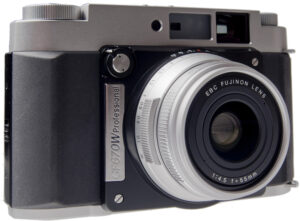
In 2011, one final camera, a version of the GF670 and Bessa III with a wider 55mm lens would be released. The camera was called the Fujifilm GF670W Professional and would have a fixed lens design, eliminating the folding door and bellows of the original model, likely due to interference from the door using the wider lens. Other small changes would be a red LED shutter indicator visible in the viewfinder and a few other minor cosmetic changes. Although I could not find any mention of the retail price, an article from a 2010 issue of the British Journal of Photography suggested the W would retail for around the same price as the regular GF670.
In the years following the release of the GF670, Fuji would exit the film camera making business, and slowly discontinue their various instant and film print lines. The lone bright spot in Fuji’s film lineup was their Instax line of compact instant film cameras, but these were all low end cameras targeted at teenagers rather than serious photographers.
Today, the Fujifilm GF670 Professional (and Voigtländer versions) have developed a sort of cult following because of their excellent performance, old school design, but modern conveniences. Many people consider these the best medium format cameras ever made. While that is an ambitious claim, they certainly are very good, and definitely worthy of their constant praise and high prices they fetch on the used market. Most people can’t afford, or at least aren’t willing to spend the amount of money required to own of these, but if you do, it is not likely you’ll be disappointed.
My Thoughts
Of all the companies who made medium format cameras, I probably have the most experience with Fuji. I’ve shot and reviewed a large number of Fuji cameras, from the FP-1 Professional Instant camera, to the Fujifilm GA645Wi Professional fully automatic 4.5×6 camera, to the Fujicaflex Automat TLR from the 1950s. If there’s one company that knows how to make a good medium format camera, it is Fuji/Fujica/Fujifilm, or whatever they want to call themselves.
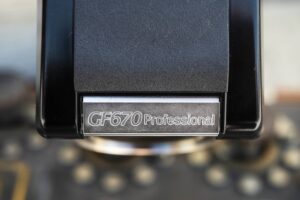
The Fujifilm GF670 Professional came to me via the collection of Kurt Ingham and was one that I was particularly interested in shooting. I liked the old school folding design with the modern conveniences of auto exposure and one of the best coupled rangefinders I’ve ever seen on any camera. The GF670 was compact and when folded, fit into a coat pocket, but still felt heavy and solid, like a professional camera should.
When I first picked it up, I was impressed with the build quality. The camera weighs 1016 grams or about 2 and a quarter pounds. This isn’t a light camera. I also enjoyed the thick rubber covering of the sides and back. On the side of the camera where your right hand grips the camera while shooting, there is a raised hump which aides in your fingertips to securely hold the camera. It is not as deep as that of a Nikon DSLR, but it is still certainly enough to confidently walk around shooting this camera all day.
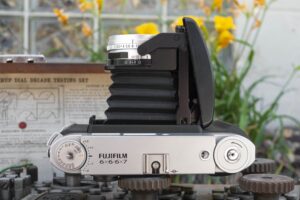
The top plate is rather symmetrical with a hotshoe dead in the center and two equally sized knobs on each end. The knob on the left is the combined shutter and film speed knob. Shutter speeds are chosen by turning the entire knob to one of the 13 shutter speeds from 1/500 to 4 seconds plus Bulb, or to a 14th location indicated by a red letter “A” for Auto Exposure mode. The camera supports aperture priority AE, so when setting the camera to this position, the camera will automatically select a shutter speed that works with whatever f/stop you’ve chosen on the lens. With the dial set to “A” mode, you can adjust EV by +/- 2 stops by pressing a chrome button in the center and lining up the red A with a printed EV scale on the main top of the top plate. You must also press and hold this chrome button to go back to using manual shutter speeds as well.
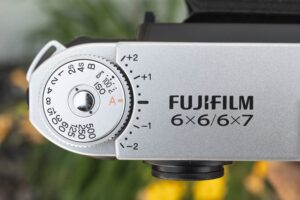
Film speeds from ASA 25 to 3200 are chosen by lifting up on the shutter speed dial and rotating it while looking at a small window showing the selected speed within. This arrangement of changing shutter and film speeds is very familiar to 35mm SLR and rangefinder cameras of the late 20th and early 21st centuries. Curiously, the GF670 no longer supports Fuji’s barcode system which was their attempt at DX film encoding, but for medium format film. This system was used by a number of the company’s medium format cameras from the 1990s, but never really caught on by other camera and film makers. I guess by 2010 they had given up on the technology.
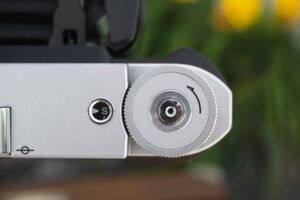
On the opposite side of the top plate is an automatic resetting exposure counter, and film advance knob. The exposure counter automatically resets when opening the back of the camera and is coupled to both the 120 / 220 film switch and the 6×6 / 6×7 switch, giving you anywhere from 10 to 24 exposures, depending on which mode you’ve chosen. The choice to go with a film advance knob instead of a lever was a curious one, but one that I very much like. Although there are many times where an advance lever is ideal compared to a knob, for medium format cameras, I prefer knobs as levers usually require more than one complete movement to properly advance the film. I find that turning a knob on a medium format camera until it stops instead of some vague 1.72 or 2.18 advances like you sometimes have to do on lever wind cameras. In the center of the film advance knob is the chrome shutter release, which is internally threaded for a cable release. The location of the shutter release is comfortably located within easy reach of your right index finger, although I think that a front mounted release might have been even more ergonomically pleasing.
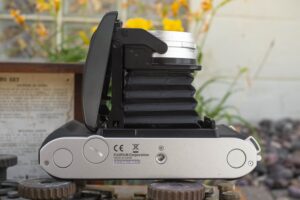
Flip the camera over and a metal 1/4″ tripod socket is in the center of the camera’s weight, giving it good balance on a tripod. To the left is the round door for the 3v CR2 Lithium battery compartment. On both sides of the camera are two round posts which pop out while loading film, and finally the camera’s serial number and a reminder that it was made in Japan.
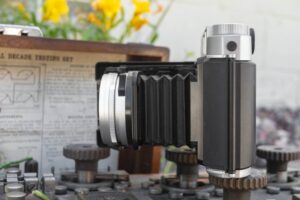
The right side of the camera has a sliding latch for unlocking the film door, and on the left, above the hinge is a PC flash sync port. Also on the left side of the camera are two metal strap lugs, one each near the top and bottom of the camera. Unlike many other cameras in which a strap connects to each side of the camera, the GF670 is supported by this one side, which actually works quite well as it allows the film door to face downward when open and the camera dangling from your neck. Had the straps been on opposite sides of the camera, the door would have precariously been off to the side when open.

Around back, there is the round eyepiece in the upper left corner for the eyepiece which has a nice rubber bumper around the end which helps avoid scratches for eyeglass wearers. In the center of the door is a square frame for inserting the end of a box of film, to remind you what kind of film is loaded. To the right of the frame is a small window that displays either 120 or 220, depending on the position of the switch in the inside of the door. Finally on the right side of the door is another thick rubber thumb bump which works in conjunction with the one on the front of the camera to make holding the camera as comfortable as possible.
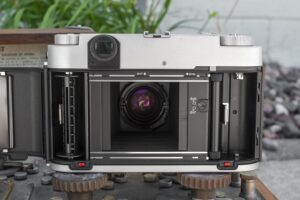
Opening the film compartment is first done by sliding a latch on the right side of the camera. The left hinged door swings open to reveal a modern roll film compartment. Film transports from left to right onto removable 120 spools. As with all roll film cameras, the old supply spool can be moved from the supply to the take up side before loading in a new roll of film. The left to right film transport makes for a more familiar location of the advance knob on the right side of the top plate, compared to many other roll film cameras in which the advance knob is on the opposite side.

Removing spools from either side is done first by pressing little red buttons below each spool which retract the bottom posts allowing you to easily slide each spool out. This method is ideal compared to older cameras in which you had to tug and hold on some kind of knob while also finagling a spool in or out of the compartment. When you have finished loading the camera, press in on two round posts sticking out of the bottom of the camera to secure the spools.
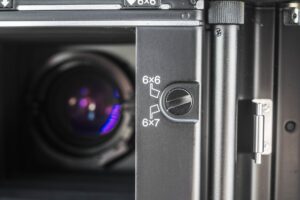
The Fujifilm GF670 Professional is a dual format camera, supporting 6cm or 7cm wide exposures. Switching between the two is done from within the film compartment, so is a choice you must make before loading a new roll of film. To accomplish this, turn a little dial to the right of the film gate to whichever position you choose. Doing this changes three things, first, it moves baffles in or out of the film gate to mask off a 6cm x 6cm or 6cm x 7cm area, it modifies the film transport to only advance the film the correct amount, and it also changes the exposure counter to correctly show the number of exposures made per roll.
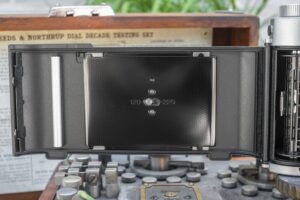
In addition to supporting two different aspect ratios, the GF670 also supports both 120 and 220 film. Although less common these days, 220 film was twice as long as 120 film, allowing for double the exposures. So in 6cm x 6cm mode, a single roll of 220 gets you 24 exposures, and 120 gets you 20 exposures. Switching between the two is done using the pressure plate on the inside of the film door. The numbers 120 and 220 are engraved into the pressure plate and switching between either requires you to press in on the pressure plate, then slide it to either the left or right side, so that a chrome post in the center is next to whichever size you are using. Moving the pressure plate also changes a small display visible on the rear of the camera, indicating which length of film is installed in the camera.
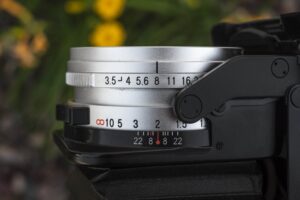
Looking down upon the top of the lens, closes to the bellows is a rather narrow depth of field scale. The 80mm Fujinon lens doesn’t offer much in the way of depth even when stopped down as at 3 meters and the smallest aperture of f/22, your depth barely reaches 2 to 5 meters. A focus scale in front of it shows distances in meters only from just under 0.9 meters to infinity. Changing the focus distance is very easy to do, care of a black plastic feeler which has a comfortable recess in the enter for your finger. I found the location of the focus ring feeler very easy to locate with the camera to your eye. In front of the focus ring is the aperture ring with strong click stops from f/3.5 to f/22.
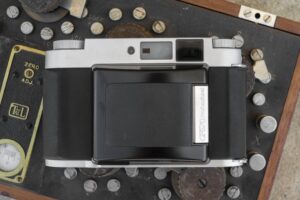
Up front, the Fujifilm GF670 Professional shows off its mostly automatic roots with absolutely no camera controls of any kind. In fact, the only thing on the entire front of the camera you’ll ever need to touch is the door release which is hidden behind a silver handle with the letters “GF670 Professional” embossed into it. With the camera closed, press in on the logo plate and using the tips of your fingers, fold the camera open. Closing the camera first requires the lens focused to infinity, and then using a black plastic lever in between the lens and the door, press this in while folding the camera shut. Do not attempt to fold the camera shut with the lens not focused to infinity or else you may damage the camera! One last comment is that when opening and closing the door of this particular camera, the bellows make a concerning “crackling” noise which is the sound you often associated with rotted out bellows from mid 20th century folding Kodaks. While the bellows on this camera are light tight and do not show any signs of dry rot, hearing this while opening and closing a relatively young camera is worrisome.
The Fujifilm GF670 Professional’s viewfinder is nothing short of spectacular. Brightness and contrast with the frame lines and rectangular rangefinder patch is as good as I’ve ever seen. The viewfinder on this camera is brighter than some straight through optical viewfinders. How Fuji managed to produce such a bright and vibrant viewfinder with a beamsplitter still taking away some of the light is nothing short of a revelation.
The frame lines correct for both parallax and field size. On many rangefinders, frame lines which only correct for parallax shift towards the bottom right as you focus close to the minimum distance, but with the GF670, the physical size of the frame lines also decrease to correct for what’s called field distortion. This is a feature found often in some Konica rangefinders like the Konica Auto S1.6 and the Koni-Omega Rapid. In addition, the frame lines change size in accordance with the 6×6 or 6×7 switch in the film compartment. Depending on the position of this switch, the shape and size of the frame lines will adjust, along with a small indicator in the bottom right corner that says either ’66’ or ’67’. Not shown in the images above, red LEDs on the right side of the viewfinder will indicate which shutter speed the metering system plans to use in AE mode, and in manual mode, both what you’ve selected and what the metering system recommends (blinking).
One oddity of the viewfinder is that even at infinity when the frame lines are the largest, there is still an excessive amount of additional space beyond the frame lines, almost as if Fuji had intended this camera to support a wide angle lens. Since this is a fixed lens camera, it was a curious decision to have so much extra space not captured on film.
Overall though, the Fujifilm GF670 Professional is a heck of a camera that when folded shut, takes up very little space. Comparing it to other pro-level medium format cameras, you’d be hard pressed to find anything with this combination of features and quality, at such a small size. There are those who will argue that cameras like the Mamiya 7 is a superior camera because it has interchangeable lenses, but not everyone can benefit from multiple lenses, yet I think everyone can benefit from portability.
Of course, all my proclaiming of this camera’s virtues are for naught if it doesn’t make good photographs, so keep reading if you want to know more!
My Results
Feeling very confident in the operational condition of this camera, and having an upcoming family trip to the Grand Canyon, I eagerly took the Fujifilm GF670 Professional with and loaded in two rolls of film. The first, was a fresh roll of Kodak Gold 200, and the second a lightly expired roll of Fuji Acros 100 which was donated to me by a site reader a couple years ago. Despite it being expired, I’ve shot numerous rolls of this Acros 100 and found it shows no signs of age and it still exposes at box speed. For the color film, I had the camera in 6×7 mode, but when I loaded the black and white Acros, I changed it to 6×6 to get a little more economy out of the roll.
The images from the Fujifilm GF670 Professional were nothing short of spectacular. I don’t know that you’ll find a measurably better medium format 6×6 or 6×7 camera with a lens sharper or able to produce as nice of results as the 6-element 80mm f/3.5 EBC Fujinon. The 80mm focal length compares to a 44mm lens on 35mm when shooting 6×6 and 40mm on 35mm film, giving an ever so slight wide angle appearance. For me, I’ve always enjoyed 40mm lenses on 35mm cameras, so the amount of visual information captured on film is appealing to me. The Fujinon compares favorably to other excellent 40 to 50mm lenses by Nikon, Zeiss, or any other top tier lensmaker with accurate colors, no noticeable vignetting or softness in the corners. If I had one criticism of the lens, it is that it produces images with such high technical characteristics, it can come off a bit sterile. When shooting 6×6, I actually prefer a more vintage look from a 3 or 4-element Rolleicord or Mamiya Six folding camera, but that’s just my preference.
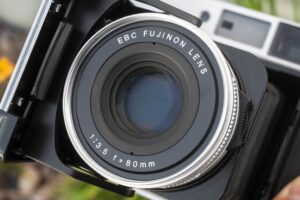
I shot the entirety of both rolls with the camera in auto exposure mode and found the metering on the Kodak Gold 200 to be spot on but the Fuji Acros 100 seemed a bit overexposed in my opinion. It is almost as if I forgot to change the film speed setting from 200 to 100, but I am certain I didn’t. At the very least, it was close enough I was able to tame the contrast in post processing to make the images above. This could be a fluke in this specific roll, or perhaps I made an error in developing, but something worth keeping an eye on if you were to try to shoot a less forgiving film.
Using the camera was a joy. I’ll admit to being a small camera guy. I find that my shooting style when out and about leans towards more compact cameras that can easily be taken out of and quickly shoved back into a sling bag or small backpack with little fuss. This results in me overlooking larger cameras like a Mamiya RB67 or even a TLR when wanting to shoot medium format, so the folding design of the Fujifilm GF670 Professional is very much appreciated. Having the flexibility of auto exposure or full manual control, plus two different film sizes adds further appeal to the camera. While I have no doubt that cameras like the Mamiya 7 or a Pentax 67 are going to make just as great of images, the lack of interchangeable lenses is a fair compromise for portability. Quite simply, I am MUCH more likely to take a camera like the Fujifilm GF670 Professional out again than I would something like a Pentacon Six.
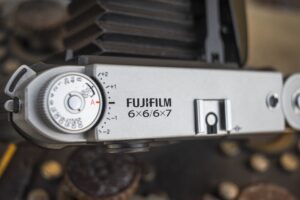
The viewfinder is incredible, mostly. With its large and extremely bright framelines and rangefinder patch, composing and focusing images is a snap. I would say the brightness and contrast of the viewfinder compare favorably to a modern Leica M6 or a Cosina Voigtländer Bessa from the early 2000s. I do however feel as though there is too much negative space outside of the framelines, almost as if this viewfinder was intended to be used on Fujifilm GF670W Professional with its wider angle lens and Fuji didn’t feel like designing two different finders. I think usability could have marginally improved had there been a bit more magnification to eliminate some of the space outside of the frame lines.
The lack of a film advance lever was not an issue for me as I found the location, design, and movement of the film advance knob to be very easy to use, and gave the camera a more symmetrical design without having to worry about a lever sticking out of the top plate of the camera. While film advance levers are generally thought to be improvements over knobs, in this case, I actually like the knob better. Finally, one other small, but nice touch is the very large door latch release which is extremely easy to locate with your right hand for opening and closing the camera without having to look at it. I could have the camera to my eye, make an exposure, and then immediately fold it shut without ever having to fumble around to locate the door release.
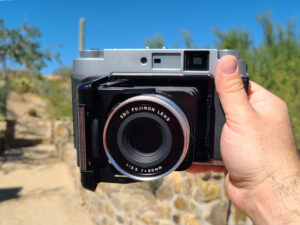
There’s little to not like about this camera as it has everything a 21st century medium format film photographer would want. The lack of interchangeable lenses is made up for the camera’s ability to fold shut. The presence of fragile bellows is always a concern for any folding camera, so some thought and care needs to be exercised when handling the camera compared to a solid bodied camera. Really, any cons I could come up with fall well within the category of nitpicks and do not at all take away from the shooting experience of an excellent “modern classic”.
Even though I do tend to lean more towards smaller 35mm cameras, I have shot my fair share of roll film cameras and I can honestly say, it doesn’t get much better than the Fujifilm GF670 Professional. Like I said, if you need different focal lengths and don’t mind a more bulbous camera, then you might want to look elsewhere, but for a general purpose 6×6 or 6×7 camera that does everything you need without anything you don’t, this camera is nearly perfect.
I realize the cost of these things is quite unobtanium to many people who might be intrigued by the praise I am heaping on this camera, and to those people, my best advice is that while this really is an excellent camera, the good news is that there are MANY other cameras from the mid 20th century who can deliver results that look just as nice. Even with a CLA, you could get a nice Yashica D TLR and make great 6×6 images or one of a jillion folding 6×9 German cameras that you can crop to 6×7 if you wish. Photography can be expensive, but it doesn’t have to be if you are willing to get creative. If however, you have the budget for a new (to you) Fujifilm GF670 Professional, then by all means buy it, as I am confident you won’t be disappointed!
Related Posts You Might Enjoy
External Links
http://camera-wiki.org/wiki/Fujifilm_GF670
https://alysvintagecameraalley.com/2021/12/23/first-thoughts-fujifilm-gf670/
https://www.stevehuffphoto.com/2010/06/17/the-fuji-gf670-film-camera-review-medium-format-lives/
https://mrleica.com/fuji-gf670-review/

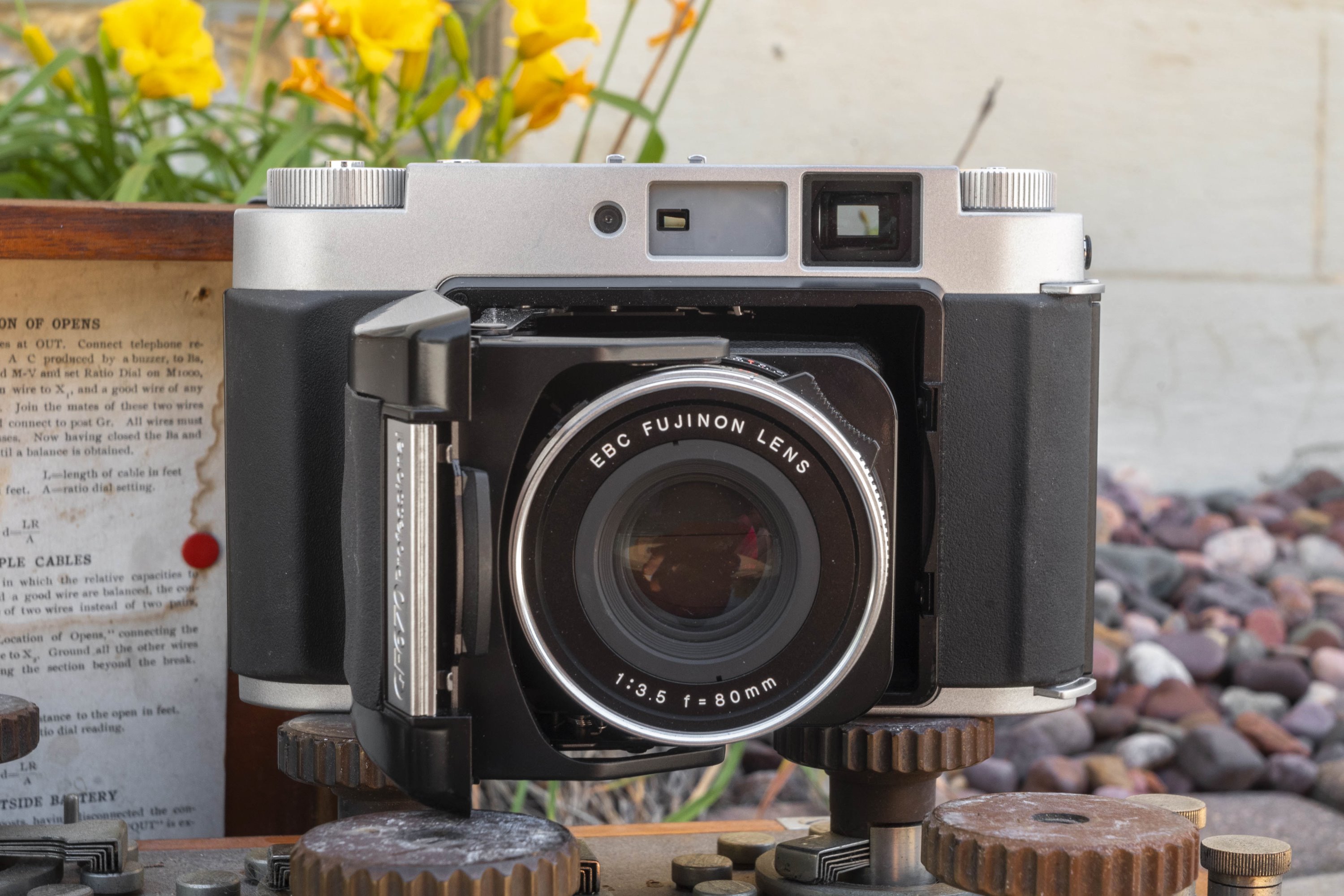
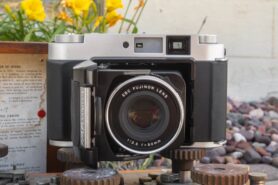
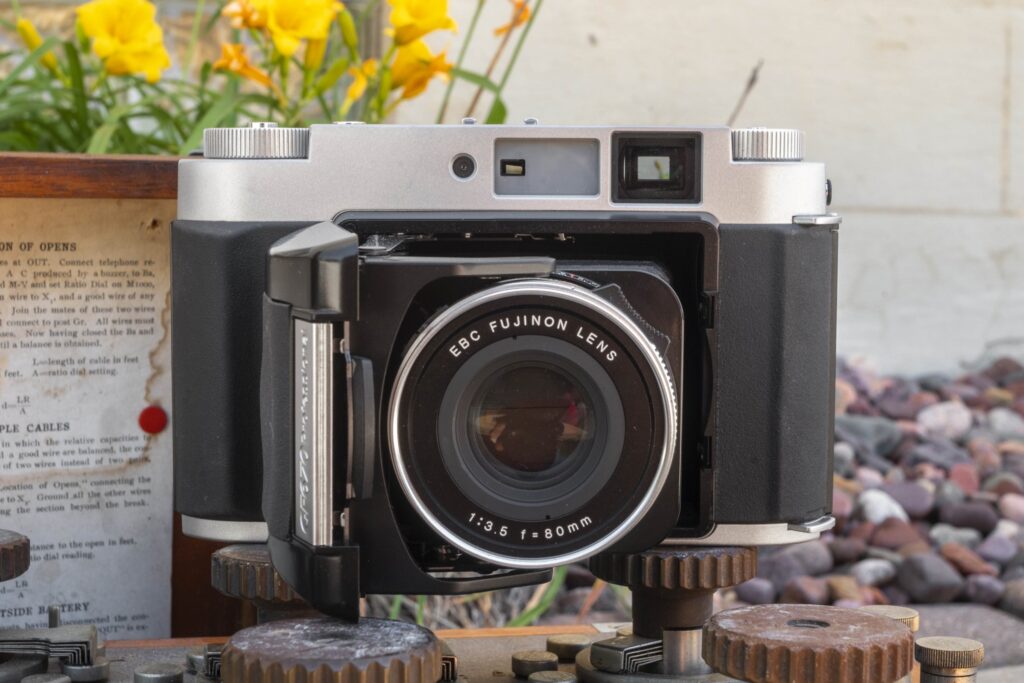
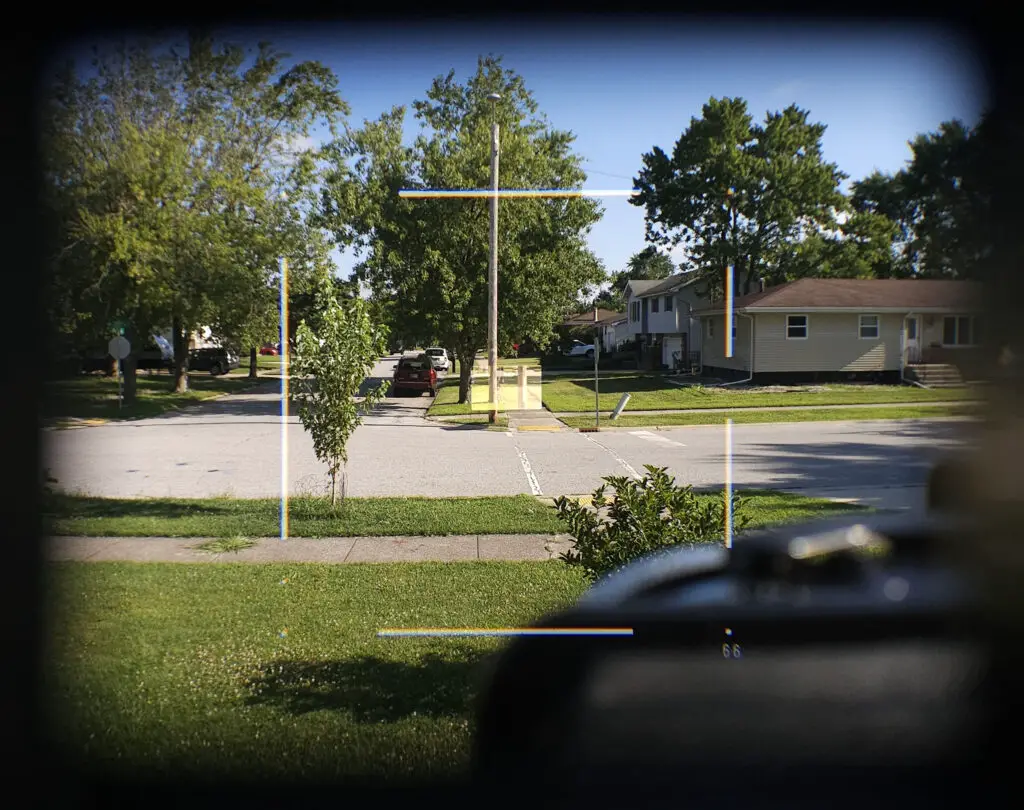
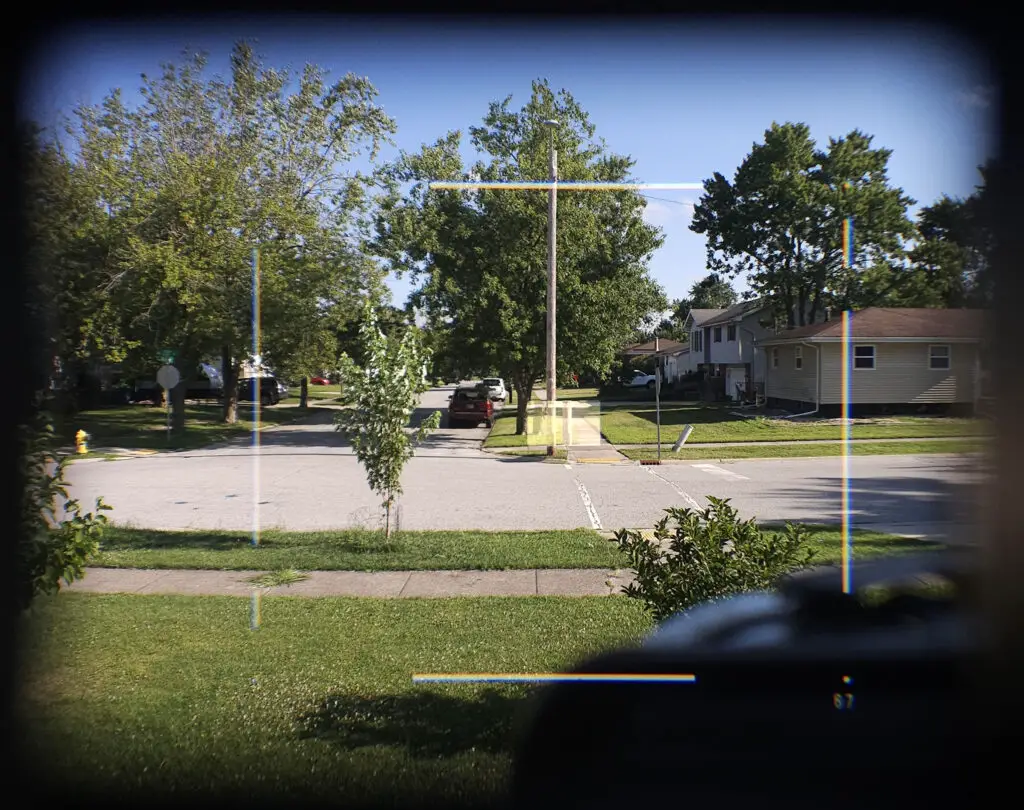














I just got one of these in a trade a couple weeks ago. It’s such a cool camera, and I enjoyed your review, Mike. One nitpick: you mention that there’s no exposure indicator in the viewfinder. That’s not true, at least on my copy. On the right side of the finder is a vertical scale showing shutter speeds. In manual shutter speed mode, the selected shutter speed is lit, and the shutter speed that the camera’s exposure meter thinks would be correct flashes. In aperture priority, the shutter speed chosen by the camera is lit. It’s talked about (in kind of an unclear way…) on pages 55 and 56 of the manual.
Andrew, thanks for pointing this out to me. A flaw in how I write my reviews is that I often shoot a camera several months before writing anything about it, so sometimes I forget small details like that. When I was writing the review and I took the “through the viewfinder” images, I no longer had any batteries in the camera to get the metering system to light up those lights. I edited the review to correct the part where I said I wished there was some exposure indication in the viewfinder. If I ever get around to it, I’ll try to retake the viewfinder images to try and show it. Thanks again!
An excellent review on an excellent camera. I’ve only tested one at a local camera store; it was way out of my price range!
Adding to your recommendation of German folders, the Voigtlander Bessa I is a great way to capture 6×9 photos if one can go without fancy features like a automatic exposure or coupled rangefinder. And it’s part of the “family” of the one you reviewed!
I agree with you, the GF670 is a great camera, for is too expensive for what it is. I was very fortunate to be able to test this camera without having to pay the current asking prices for it. My final verdict is that while I recommend the camera itself, I do not recommend buying the camera!